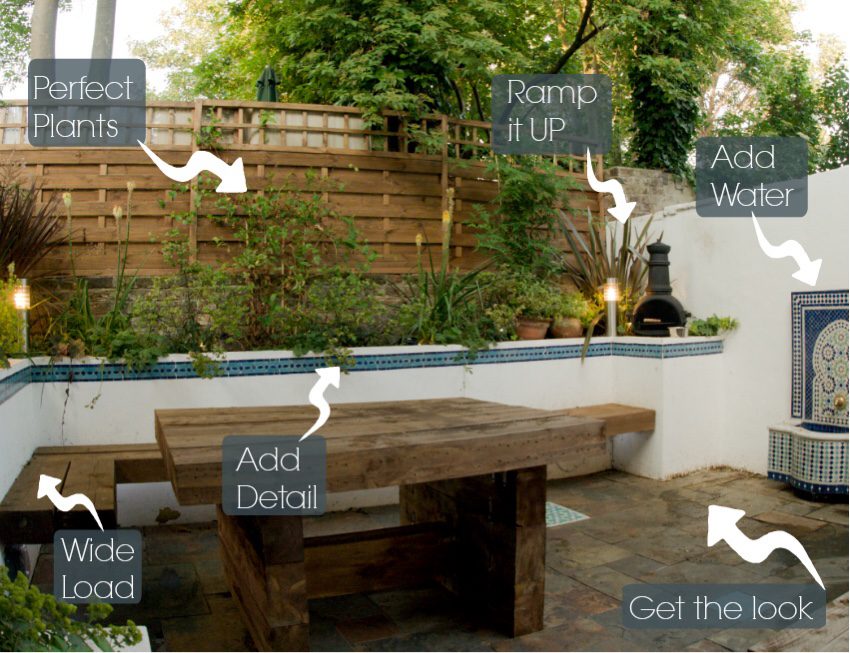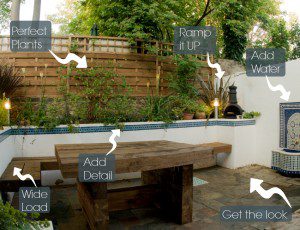How to create a Moroccan courtyard design

For centuries Moroccan courtyard design has been much copied and admired. With roots stemming from a rich Moorish heritage, Moroccan gardens feature a delicious array of beautiful colours, textures and accessories. The timeless tranquillity of the style makes Moroccan themed gardens the perfect refuge from the hustle and bustle of city life. Whether you are going for a full-on authentic design or want to combine elements of the traditional Moroccan garden with a more modern finish, there are a few intrinsic features that are essential for crafting a sensational Moroccan space.

Suggestions for nailing a great Moroccan courtyard
Get the look
Moroccan courtyard designs are mainly formal and symmetrical. Use bold geometric shapes, split the garden into quadrants and position furniture around the edge of the space where you can get a good view of the rest of the courtyard. Where possible, create a central feature. Raise the height of your boundaries to enclose the space and create more of a courtyard feeling. Include rendered raised planters, painted white and adorned with optional decorative tile detailing, to form the framework of a knockout Moroccan courtyard.
Add water
A decorative fountain water feature is essential in any Moroccan inspired design and should be the main focus of the space. Running water gives the garden a tranquil quality. A water feature will reflect the sky and give gives a sense of space. It also offers the chance for an aural experience in the space. Whether you opt for a tap on the wall, or an off-the-shelf feature, water is a must.
Plant it well
Modern Moroccan courtyards often draw inspiration from the Majorelle gardens in Marrakesh. Once owned by the late fashion designer Yvest Saint-Laurent, this iconic garden is packed with Moroccan delights. It features highly architectural, sculptural planting packed full of texture. To recreate the look in your own Moroccan courtyard use lush green tropical and sub-tropical plants. For an instant ‘established garden’ use mature evergreen spiky plants. Add succulents and cacti in terracotta pots that can be bought during the cold weather. Some suggestions for the backbone of your planted beds are:
- Cordyline
- Agave
- Phormiums
- Palms
Then fill out with texture and colour by filling in with:
- Kniophofia
- Geums
- Stipas
- Alchemillia mollis
Accessorise to excess
Add heat. It will extend the usability of the space. We liked this small chimnea. You can really max out on the rocking accessories. Add a wrought iron gate or several ornate mirrors to the wall and pepper the space with small groupings of Moroccan lanterns around the space in small groups. Arabic themed throws, cushions and rugs are a simple and cost effective way to accessorise your theme and add colour, texture and pattern.
The devil is in the detail
Some detailing using Moroccan tiles is essential. However Moroccan style encaustic tiles can be expensive, so if your budget is tight consider using them to accentuate features of the garden, as we have done in this Moroccan courtyard. Add a single row of border tiles around the the top of a raised planter, or inlay individual tiles at random within stone paving. Also consider painting your boundaries/fences. Opt for a dark deep blue unless you have white rendered raised beds/walls, in which case go for a palette of cool blue and terracotta. Cobalt blue will give stunning results with an authentic feel.
Wide seating
Try and make the seats as wide as you can – it will make the space seem luxurious and exotic. Deep seats also enable you to include lots of cushions, adding to the sensuous feel that is a feature of Moroccan gardens.

